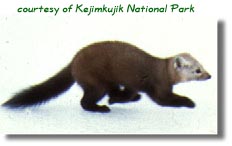|







Credits & Resources
|
Family
– Mustelidae
This group of animals makes up one of the largest groups of
carnivores, with Mustelids being found on all continents except Antarctica and Australia.
These animals range from very small (35 g) to medium (40 kg) in
size. Their body shapes vary; many, however, are long and have relatively short legs. The
tail is usually long, the ears are small and rounded, and the eyes may be small.
Mustelids have five toes on their feet and their claws can be
retracted by some species. The claws are generally short. They have a very powerful jaw.
American Marten – Martes Americana
 Description: Description:
Size: head and body 17 in. (43.2 cm) tail 9 in. (22.9 cm). Back is
yellowish-brown to dark brown. Head and belly are paler, has a pale buff patch on the
throat and chest. Legs, tail and ears are dark, head is small and feet are partly furred.
Similarities:
Mink is darker, with shorter tail, and white patch on chin. Fisher
is darker and larger.
Habitat:
Coniferous forests
Habits:
Largely arboreal, but also hunts on the ground and occasionally in
water, does not hibernate.
Voice:
High pitched screams and squeals.
Life Span:
10 years
Food:
Various, including squirrels, mice, birds, eggs and fish.
Reproduction:
3-5 young, born on leaf–lined nest in hollow tree in March
and April after a long gestation period of 220 – 265 days.
Range:
Formerly throughout the boreal forest of Canada and northern
United States they are now rare or extirpated over much of southern range.
Other Name:
Sable
The marten was native to Nova Scotia before trapping and habitat
changes reduced their population in the early 1900s. They were reintroduced in
Kejimkujik National Park in the late 1980s and have established a small population.
Martens are associated with mature softwood forests with abundant dead and downed trees
for denning and hunting.
Fisher –Martes Pennanti
Description:
Size: head and body 25 in. (63.5 cm) tail 15 in. (38.1cm). Blackish-brown, head and shoulders grizzled, legs and tip of tail black, tail bushy and tapering.
Similarities:
Marten is smaller, lighter and has light patch on chest.
Habitat:
Dense mixed forests.
Habits:
Mainly nocturnal and solitary
Voice:
Scream and hiss.
Food:
Squirrels, mice, raccoons, rabbits, some vegetable matter and
carrion.
Reproduction:
1-5 (usually 3) young, born in late March or April. Females mate
shortly after birth of young. Delayed implantation accounting for the long period of
gestation.
Range:
Same as marten, throughout the boreal forest of Canada and
northern US.
This species, native to Nova Scotia, was reduced to extremely low
population numbers early in the twentieth century from heavy trapping and habitat changes.
Fishers were successfully reintroduced to the western end of the province in 1947.

|



